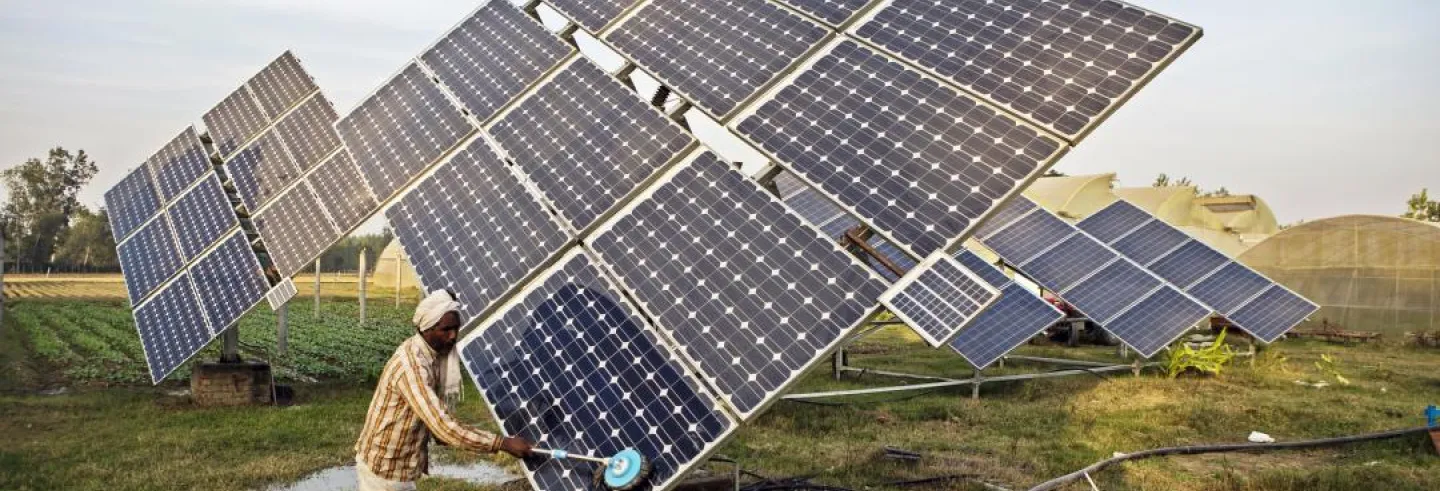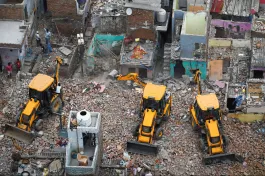India has just about managed to crawl out of the Covid-19 crisis, but we are not sure if there is a fourth wave awaiting us. The experience of the pandemic has exposed a broken health system. This is not the only crisis that we have had to deal with. The Covid-19-induced lockdown of 2020 and the ensuing economic recession came atop a severe slowdown in the economy, which had begun in the fourth quarter of 2017-18.
It would not be an exaggeration to argue that compared with the 2000s, the economy now seems to be stagnating. If not addressed, it might take a long time to recover.
A crisis, however, can also be seen as an opportunity to break free from the past. Why do more of the same if we have an opportunity to change course? We cannot afford to merely tinker here and there. What is required is rethinking our development model and chalking out a just, inclusive, and sustainable path. We present here what needs to be done in the form of an Indian Green Deal (IGD) and how it has to be done.
In 2020, the Indian government promised 10% of the gross domestic product (GDP) as an atmanirbhar (self-reliance) package for Covid-19 recovery. Taking that as a peg, we propose an alternative and a more fruitful way of spending that amount. Our plan comes with a 10-year horizon, which is the minimum required if we want to overhaul the energy system of the country. Although 10% of the GDP spent per annum may sound like an awful lot, the programme can be scaled up or down, except for the green energy part, depending on the availability of finance (an issue we discuss later).
There is no point in planning a fossil fuel-intensive infrastructure in the 21st century when the entire world is debating moving away from it.
We envisage dividing the overall programme into three categories or components — infrastructure development, a care programme, and a green energy programme. We have identified these three components because we believe that this should be the economic path for the future. It helps that the employment-generating capacity of these sectors is quite high. Chart 1 presents the expenditure of the programme, which is 5%, 3%, and 2% of GDP under the three categories. respectively
The first component entails developing the country’s transport system (including the railways, inland water transport, and roads) and its irrigation and water infrastructure; overhauling its waste management system; revitalising its internet services; and, last but not the least, promoting agricultural research and training.
It might seem like we are proposing the same thing as what the union budget for 2022-23 did. But we have a different take. In the absence of a clear signal about the nature of the capital expenditure in the budget, it is safe to assume that it proposes to build more of the same kind of infrastructure that we currently have. We, on the other hand, believe the thrust of this infrastructure expenditure should be on “greening” each of these areas. 1To be sure, there will be some dependence on cement for certain sub-sectors in particular, and cement is an energy-intensive and carbon-intensive industry. Only very recently in Germany, there has been some success in reducing the carbon intensity of that industry.
It should be easier to do so since this will be a new initiative. There is no point in planning a fossil fuel-intensive infrastructure in the 21st century when the entire world is debating about moving away from such an approach.
The second component of the IGD — the care programme — is partially an attempt to address the broken Indian healthcare system and improve the public education system. It was amply clear during the several waves of Covid-19 that an insurance-based private healthcare system could not handle a health crisis of this magnitude. It is unimaginable in today’s world for people to die due to lack of oxygen and basic healthcare facilities. Stories of private hospitals overflowing with Covid-19 patients still survive in public memory. If alternative temporary healthcare arrangements had not been made by different state governments, things would have been worse.
But do we really need to depend on last-minute planning when it comes to an issue as serious as the life and death of common citizens? The state has to be primarily responsible for providing affordable and good-quality healthcare to all its citizens. That responsibility does not stop with merely providing health insurance to the needy; there needs to be public provisioning of health. Private health can at best play a complementary role.

How green is the IGD?
The green energy part of the IGD attempts to overhaul the underlying energy system of our economy. There are two levers through which the carbon intensity of an economy can be brought down — through supply and demand. From the supply side, it can be done by gradually changing the energy mix of the economy from a fossil fuel-based system to renewables. From the demand side, it can be brought down either by a carbon tax or by imposing caps on emissions.
There are three ways of cutting emissions — by moving towards lower carbon-emitting fossil fuels (compressed natural gas or liquified petroleum gas, for example); by decreasing the energy intensity of the economy (which is quite high for India); and by increasing investment in greener forms of energy. We propose that the green energy component of the IGD be distributed across these three paths.
Our research presented elsewhere (Azad and Chakravarty 2020) presents the details of these supply-side measures. Chart 2 presents the projected carbon emissions in a decade. Our proposal, if implemented, will cut emissions by one-third compared to India’s Stated Policies Scenario (STEP in the chart) of the International Energy Agency (IEA).

What is the employment deal?
The total jobs and their distribution across the three components of the IGD are presented in Chart 3. For specific sectors within the three components of the programme, we calculate employment multipliers by matching the sectors according to an input-output matrix with the corresponding ones in the National Sample Survey (NSS) on employment. The IGD could generate a total of 38.6 million jobs, which would be equivalent to 8.2% of the Indian labour force. Not only does this absorb those unemployed now, but it also addresses, at least partially, the problem of disguised unemployment in the economy. A new study (Azad and Chakraborty, forthcoming) presents the underlying employment numbers at a more granular level.
 On the positive side, these jobs are mostly in the rural sector. They favour people with low education and skills and they benefit those belonging to the marginalised sections. Caste representation in these jobs is even higher than what reservations would have provided. All this means that it would be helpful to pull less-educated people out of poverty. The numbers though are not as favourable when it comes to women. In the absence of any active intervention to ensure a better gender composition, only one out of 10 jobs will be offered to women, except in the care economy and a few other sub-sectors.
On the positive side, these jobs are mostly in the rural sector. They favour people with low education and skills and they benefit those belonging to the marginalised sections. Caste representation in these jobs is even higher than what reservations would have provided. All this means that it would be helpful to pull less-educated people out of poverty. The numbers though are not as favourable when it comes to women. In the absence of any active intervention to ensure a better gender composition, only one out of 10 jobs will be offered to women, except in the care economy and a few other sub-sectors.
While the number of jobs created may be high and their caste and regional composition encouraging, there is no guarantee that they will necessarily be of good quality. This is particularly so because the estimates are based on the current quality of jobs prevailing in these sectors. So, if a large proportion of workers are currently employed in an informal status within a sector, it would reflect in this programme in the absence of an active policy to reverse the prevailing situation. Not surprisingly, therefore, a large number of such jobs have no additional benefits as opposed to those with social benefits.
Given the low quality of jobs, the jobs created through this programme must have an inbuilt social security system, which should be possible because the state is the employer. Labour rights, decent minimum wage laws, and a strict adherence to rules are some of the measures well within the perimeter of the state’s influence. And to address gender under-representation, provisions for reservations for women can be built into the programme.
Now the elephant in the room: where is the money to finance the IGD going to come from? A share of 10% of the GDP per annum for 10 years is a lot and may make the proposal look a tad non-serious. Before readers take such a view, allow us to present our case. That we, as humankind, need to do something significant (and soon) to avert the impending climate crisis is non-negotiable. The issue is the quantum of our efforts. We present two options (or some combination of the two) of how this could be done.
Option 1: Global high emitters pay
One option — the fairest of them all — is that the advanced capitalist countries pay for the energy transition since they are primarily responsible for the mess we are in. As we had shown in a previous piece in the Hindustan Times, if we look at the stock of emissions till date, the global North has emitted four times more than their share of the global population, whereas Asia (minus Japan) has emitted less than half their share in the population in the same period. If we were to go by the current flows of emissions, the global North emits more than double their share, while Asia still emits a little less than their share in the population. It is obvious that the responsibility of adjustment should fall primarily on those who emit more.
Based on this broad definition of fairness, we arrive at a simple principle. Those who currently emit more than the global per capita average should compensate and fund the energy transition of those who emit lower than the average for the next decade. And the quantum of per capita compensation would depend on how far a country is away from the global average. A global pool of funds to fight climate change thus gets created.
India [will be] the biggest beneficiary of ... a green fund transfer because our per capita emission is below the global average and our population is large.
Based on calculations in Azad and Chakravarty (2019) the world can be divided into two parts — the payers and the beneficiaries. If we plot this on the global map, Chart 4(a) represents the quantum each payer country needs to contribute to the global fund, and Chart 4(b) what the beneficiary countries receive from it. The total amount for a country is a multiple of the per capita payment/benefit and the population of that country.
India will be the biggest beneficiary of such a green fund transfer because our per capita emission is below the global average and our population is large. This amount, as it happens, is sufficient to fund the IGD.
Though good as an idea, this option may not be easy to implement since there are global players involved. But this could provide a roadmap for international negotiations. For the plan to see the light of day, the “beneficiary” countries in the South need to collectively fight as a bloc for compensation and technology transfer.


Option 2: Domestic high emitters pay
Just as at the global level where the richer countries emit more, there is a huge class division in carbon emissions within our country. It is this difference that can be exploited to fund the IGD. Chart 5 gives us a sense of how different classes emit carbon in India. With the population divided into deciles, we measure their emissions based on their consumption baskets as in the NSS — the per capita emissions rise as we move up the income ladder. The richest 10% Indians emit almost seven times as much as the poorest 10%. The richest two deciles contribute almost 40% of the total carbon emitted whereas the bottom 20% emit just a little over 10%.

Any mitigation effort, therefore, has to invert this carbon injustice by making the richer sections pay for the energy transition. This can be done through a combination of a wealth tax (including inheritance and short-term capital gains) and a higher corporate tax. The former is almost non-existent and the latter is low in India. These two can fund the infrastructure and care economy parts of the programme. If we were to split the two taxes equally, they would need to mobilise $104.9 million (Rs. 801.5 crore) each.
Air travel needs to be way more expensive than trains for the same journey. And those who would still prefer to travel by air need to shell out much more...
On the other hand, the green energy programme can be financed through carbon taxes, including a significant luxury goods tax. Carbon taxes play an important role on the demand side of emissions. Commodities with high carbon embodied in them need to become more expensive for people to move away from consuming them. A simple example may help explain this. Air travel needs to be significantly more expensive than trains for the same journey. Those who still prefer to travel by air need to shell out much more than they currently do. Given the huge difference between per passenger emissions of the two modes of transport, not only will this bring emissions down, but it will also generate funds to further green the transport infrastructure and make it more accessible to the poorer sections of the population.
The problem with a carbon tax is that unlike the other taxes proposed, it is regressive in nature since the poor and the rich pay the same amount for a given commodity. To compensate for that, a carbon dividend — either in cash or kind in the form of free electricity, public transport, and free rations — can be built into the policy proposal. As an example of what the tax and dividend policy would like, we present in Chart 6(a) the carbon charge and the monetary value of such dividends (benefits) for each decile.

While carbon taxes are regressive (the burden is higher on the poor than the rich), carbon dividends are progressive. On balance, as Chart 6(b) shows, the net benefits invert the carbon injustice presented in Chart 5. The poorest gain the most and the richest pay for it and the economy becomes greener in the process. Those who contribute the most to the problem compensate those who face the brunt of it.

Conclusions
If implemented, the IGD would help resolve multiple issues at the same time. It would help India do its bit in fighting climate change, while providing green jobs. Through carbon dividends, it will hit at the heart of income and carbon inequality in the country. It is a progressive alternative, of people-over-profit thinking, instead of the unthinking (and regressive, in the sense of its adverse impact on climate justice) initiative that the government seems to be embarking on through its call to all to take advantage of Amrit Kaal.
Rohit Azad teaches economics at Jawaharlal Nehru University. Shouvik Chakraborty is research assistant professor at Political Economy Research Institute, University of Massachusetts, Amherst.











Ignored dimensions, questionable assumptions